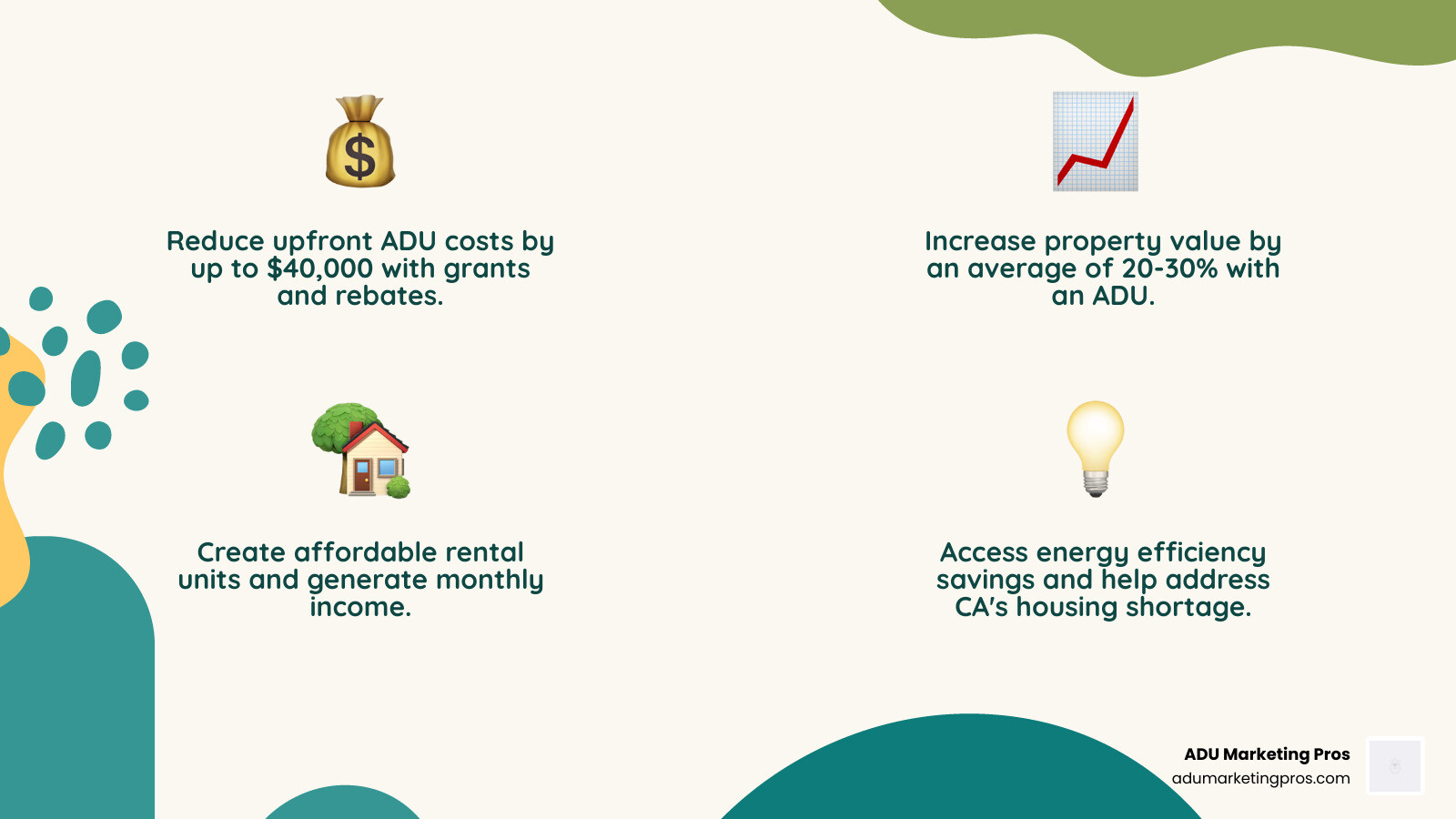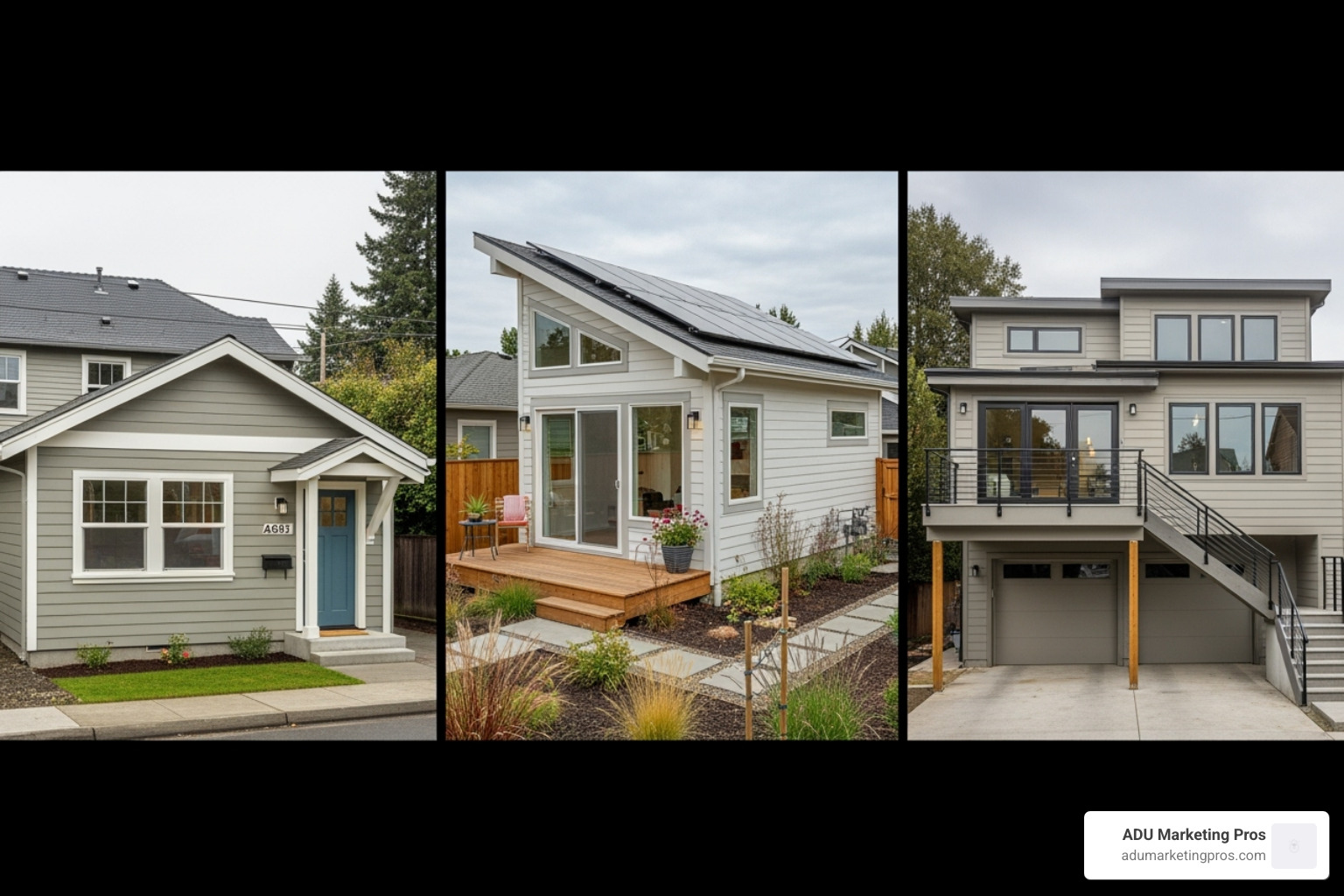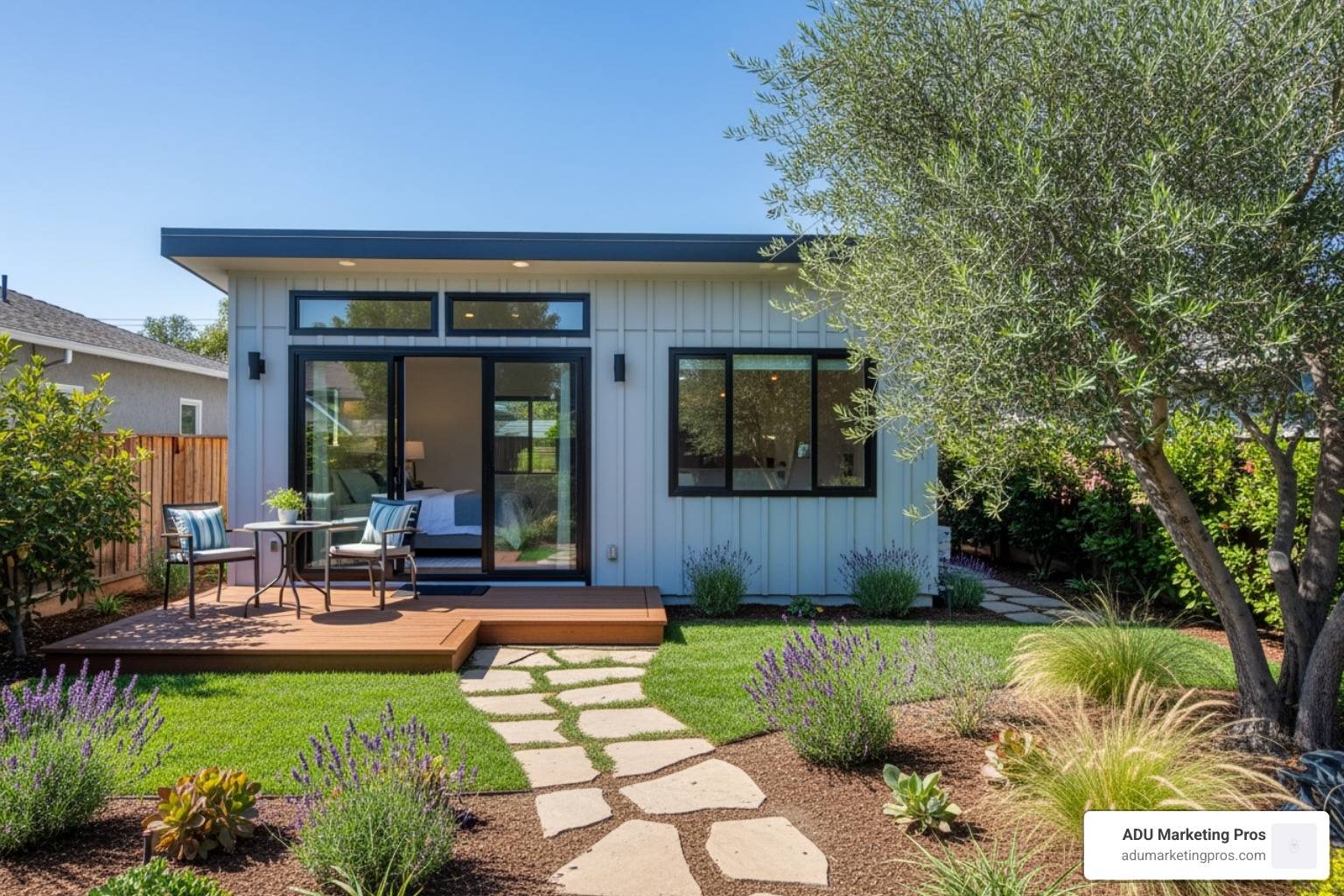Why adu rebates california Programs Are Your Financial Launchpad
If you’re a California homeowner, you’re likely aware of the state’s persistent housing crisis. The dream of homeownership is slipping away for many, and affordable rental options are scarce. Accessory Dwelling Units (ADUs) have emerged as a powerful solution, offering a way to add housing within existing neighborhoods without the need for large-scale development. Recognizing this potential, the state and local entities have rolled out a suite of adu rebates california programs designed to turn your ADU project from a dream into a reality. These financial incentives are not just minor discounts; they are substantial financial launchpads that can dramatically lower the barrier to entry.
These programs are a direct response to the need for creative housing solutions. By encouraging homeowners to build, they help increase the housing supply with what is often called “gentle density.” To make this happen, government agencies and utility companies are offering tens of thousands of dollars in financial aid. Here’s a glimpse of the powerful incentives available:
- CalHFA ADU Grant Program: This flagship state program offers up to $40,000 for pre-development costs. For many homeowners, this amount can cover the entire expensive phase of design, planning, and permitting before a single shovel hits the ground.
- Local City/County Programs: Ranging from $2,500 to over $15,000, these programs are tailored to local needs. Many offer significantly higher amounts if you commit to renting the unit to a low-income tenant, directly addressing local affordability goals.
- Utility Company Rebates: Providers offer up to $6,500 or more for building an energy-efficient, all-electric ADU. This not only reduces your construction costs but also lowers your long-term energy bills.
- Energy Efficiency Bonuses: On top of primary rebates, you can find stackable bonuses, like an extra $3,000 just for installing an induction cooktop, promoting cleaner and safer indoor air quality.
These programs make ADU projects financially viable for a much broader range of homeowners, adding critical housing capacity without requiring new land or massive public infrastructure. The landscape of available rebates is diverse and dynamic, covering everything from architectural plans and soil tests to energy-efficient appliances and EV charger readiness. However, this funding is not infinite. It’s often limited, competitive, and awarded on a first-come, first-served basis. The popular CalHFA grant, for instance, has seen its funding rounds exhausted in a matter of days. This guide is designed to be your comprehensive roadmap, breaking down every major rebate and grant opportunity and providing the exact steps you need to take to secure funding for your ADU project.

Understanding the Landscape of ADU Rebates in California
California offers a multi-layered system of adu rebates california programs as a core strategy in its fight against the severe housing shortage. By removing significant financial barriers, these incentives empower individual homeowners to become part of the solution. Building an ADU adds housing to existing neighborhoods quickly, affordably, and with minimal disruption. This approach benefits homeowners directly with financial aid and the potential for rental income, while communities gain desperately needed housing stock without sprawling new development.
To navigate this landscape, it’s crucial to understand the two main types of incentives: rebates and grants. Think of a rebate like a mail-in rebate for an appliance; you pay for the cost upfront (e.g., a permit fee or a heat pump), and the program reimburses you after the fact. This is great for reducing the total cost but requires you to have the initial cash. A grant, on the other hand, is more like a scholarship. It often provides funds upfront to cover specific costs, particularly pre-development expenses, and it does not need to be repaid. Grants are ideal for managing cash flow and overcoming the initial financial hurdle that stops many projects before they start.
These valuable programs are funded and administered by several different types of organizations:
- State Agencies: The California Housing Finance Agency (CalHFA) is the most prominent, running the largest statewide grant program aimed at covering soft costs.
- Local Governments: Cities and counties across the state offer their own rebate and grant programs. These are customized to local housing needs and priorities, so an incentive in Los Angeles might look very different from one in Sacramento. You’ll typically find these on your local city or county’s Planning Department or Housing and Community Development website.
- Utility Companies: Major providers like Pacific Gas & Electric (PG&E), Southern California Edison (SCE), San Diego Gas & Electric (SDG&E), and the Sacramento Municipal Utility District (SMUD) offer incentives focused on promoting energy efficiency and building electrification.
These efforts are all aligned with the goals of the California Statewide Housing Plan, which calls for the creation of more diverse and affordable housing options. The most powerful aspect of this system is that you can often “stack” these incentives. For example, a homeowner in a participating city could potentially combine a $40,000 CalHFA grant for pre-development costs, a $10,000 local city rebate for completing construction, and a $5,000 utility rebate for installing all-electric appliances. This could total over $55,000 in savings, covering a substantial portion of the entire ADU project cost. Understanding how to identify and combine these resources is the key to maximizing your financial advantage and making your ADU project as affordable as possible.
Statewide Programs: The CalHFA ADU Grant

The most significant and sought-after statewide opportunity is the California Housing Finance Agency (CalHFA) ADU Grant Program. This program was specifically created to help low-to-moderate-income homeowners overcome the high upfront “soft costs” that occur long before construction begins—the very costs that can derail a project due to cash flow challenges.
Program Details and Funding
The CalHFA ADU Grant provides up to $40,000 as a grant, not a loan, meaning it does not need to be repaid. This funding is designated to cover pre-development and non-recurring closing costs associated with the construction financing. These are expenses like architectural designs, engineering, soil reports, city permits, and impact fees that can quickly add up to tens of thousands of dollars.
It is impossible to overstate the popularity of this program. Funding is allocated by the state in rounds, and when a new round opens, the funds are typically depleted with astonishing speed—sometimes within days or even hours. To have a realistic chance at securing this grant, you must be proactive and prepared. Bookmark the official CalHFA ADU Grant Program page and check it religiously for announcements on new funding availability. Having all your documentation ready to go before an announcement is made is absolutely critical.
Eligibility and Covered Costs
Eligibility for the CalHFA grant is targeted to ensure the funds help those who need it most. The primary requirements include:
- Income Limits: Your household income must be at or below 150% of the Area Median Income (AMI) for your county. You can find your county’s specific income limits through resources provided by CalHFA or HUD.
- Property and Occupancy: The property must be an owner-occupied single-family home, and you must intend to occupy the primary residence during the construction of the ADU.
The grant covers a wide range of essential pre-development expenses, including:
- Architectural designs and structural engineering
- Site prep, surveys, and soil tests
- Title 24 energy reports
- ADU permit costs and impact fees levied by the city or county
- Property survey and septic/well inspection fees
- Title, escrow, and other non-recurring loan origination fees
The Crucial Role of the CalHFA-Approved Lender
A unique aspect of this program is that homeowners cannot apply for the grant directly. The application must be processed and submitted on your behalf by a CalHFA-approved lender. These lenders are your gateway to the grant. They are trained on the program’s specific requirements and will guide you through the entire process. Your lender will help you gather the necessary documentation—such as pay stubs, tax returns, bank statements, and preliminary ADU plans—and will submit the complete application package to CalHFA for you. It’s wise to connect with an approved lender well in advance of a funding round announcement to get pre-qualified and have your file ready to submit the moment applications open. For more context on how this grant fits into your overall funding strategy, see our guide on the Accessory Dwelling Unit Grant Program.
Local Heroes: City and County-Specific ADU Rebate Programs

While the CalHFA grant captures headlines, a rich tapestry of adu rebates california programs exists at the local level. Many cities and counties offer their own incentives to spur ADU development, and these are often designed to address specific community housing goals. The best part? These local incentives can frequently be combined with state and utility funding, creating a powerful stack of savings. To understand how these programs fit within the broader regulatory framework, our California ADU Guidelines provide essential context.
Differentiated Rebates: Low-Income vs. Non-Restricted ADUs
Many local programs have a tiered structure that offers significantly higher rebate amounts if you agree to rent your new ADU to a low-income or very-low-income tenant for a set period. For example, a city might offer a $7,500 rebate for a standard, market-rate ADU but increase that amount to $15,000 or more for a deed-restricted affordable unit.
Committing to a “low-income restricted” unit is a major decision. It typically involves recording a deed restriction on your property for a term of 10 to 20 years. This legal agreement caps the maximum rent you can charge based on a percentage of the Area Median Income and requires that your tenant’s income is below a certain threshold. While it’s a long-term commitment that limits your potential rental income, the substantial upfront financial incentive can make a project feasible that otherwise wouldn’t be. This tiered system offers homeowners a meaningful choice: take a smaller rebate with full freedom to set rent, or accept a much larger rebate in exchange for contributing a guaranteed affordable housing unit to the community.
Spotlight on Local Programs: Examples Across California
Local programs vary widely. Here are a few examples to illustrate the diversity:
- San Jose: The city has offered fee waivers and pre-approved ADU plans to streamline the process.
- Los Angeles: The county’s ADU Accelerator Program connects homeowners with services and helps them navigate the process, sometimes offering financial assistance for affordable units.
- Concord & Lafayette (Bay Area): These cities have offered tiered rebates, providing up to $15,000 for low-income restricted ADUs versus $7,500 for non-restricted units.
- Santa Cruz: Has offered fee waiver programs to reduce the high cost of permits and impact fees.
To find programs in your area, start by searching the official website for your city or county’s Planning Department or Housing and Community Development department.
Size Restrictions and Timelines
Local programs almost always come with specific rules and deadlines. Rebate amounts are often tied to the ADU’s size, rewarding the construction of smaller, more inherently affordable units. The City of Concord, for example, previously offered its highest rebates for units under 500 sq. ft., with the rebate amount decreasing as the unit size increased, and phasing out entirely for ADUs over 1,000 sq. ft.
Timelines are also strict and non-negotiable. Most programs require you to obtain your building permit within six months of your rebate application being approved and reserved. Following that, you typically must complete construction and pass the final inspection within 18 to 24 months of the permit issuance date. Missing these deadlines can mean forfeiting your reserved funds, which are then passed to the next person on the waiting list. It is crucial to have your project well-planned and ready to move forward before you apply.
Powering Up Your Savings: Utility Company and Energy Efficiency Rebates
Beyond government grants and local programs, California’s utility companies provide another powerful layer of adu rebates california that focus on energy efficiency and building electrification. These incentives are a win-win: they help you reduce the upfront construction costs of your ADU and also lead to lower monthly energy bills for the life of the unit. Crucially, these utility rebates can almost always be stacked with state and local government incentives, further deepening your total savings.
All-Electric and High-Efficiency Incentives
In line with California’s ambitious climate goals, utility providers across the state—including SMUD, PG&E, SoCal Edison, and SDG&E—are actively promoting the construction of all-electric homes. They offer substantial rebates for installing modern, high-efficiency electric appliances instead of gas-powered ones. Common rebated items include:
- High-Efficiency Heat Pumps: These all-in-one systems provide both heating and cooling far more efficiently than traditional furnaces and air conditioners.
- Heat Pump Water Heaters: They use ambient air to heat water, consuming a fraction of the energy of standard electric or gas water heaters.
- Induction Cooktops: These offer precise temperature control, are safer than gas stoves, and eliminate the indoor air pollution associated with burning natural gas.
- EV-Ready Wiring: Many programs offer incentives for pre-wiring the ADU for a future Level 2 electric vehicle charger, making the property future-proof.
The statewide Energy Smart Homes rebate program is a major opportunity for customers of California’s largest utilities. It’s designed to reward homeowners for building new, all-electric homes—and ADUs qualify.
Maximizing Your Rebate Potential
To unlock these savings, you must plan for energy efficiency from the very beginning of your design process. The Energy Smart Homes program, for instance, offers tiered rebates based on the overall efficiency of your ADU, with potential rebates reaching up to $6,500 for a fully electrified, high-performance unit. You can then stack this with additional bonuses offered by the same program. For example, you might be eligible for an extra $3,000 rebate just for installing an induction stove that has an integrated battery, which can provide backup power during an outage.
Imagine this scenario: you build an all-electric ADU and qualify for a $5,000 rebate from the Energy Smart Homes program. You also install an induction cooktop, adding another $3,000 bonus. Your local utility might offer an additional $500 for a heat pump water heater. That’s $8,500 in savings from utility incentives alone, which you can then add to any local or state grants you receive. By strategically incorporating energy efficiency into your ADU plans, you can offset tens of thousands of dollars in costs and create a modern, comfortable, and sustainable living space with lower utility bills for years to come.
Your Step-by-Step Guide to Securing ADU Rebates in California
Navigating the world of adu rebates california can feel daunting, but it’s a manageable process when broken down into a clear plan. Following these steps methodically will help you stay organized, meet critical deadlines, and maximize your chances of securing thousands of dollars for your ADU investment. For more on regulations, our guide to ADU Construction Regulations is a valuable resource.
Step 1: Research and Identify Available Programs
Your first task is to become an expert on the incentives available to you. Cast a wide net. Create a master spreadsheet to track potential programs, their requirements, and deadlines.
- Statewide Grants: Start with the CalHFA ADU Grant. Check the official website for funding status and eligibility requirements.
- Local Programs: Visit your local city and county planning department websites. Use search terms like “ADU grant,” “ADU rebate,” or “accessory dwelling unit incentive.” Some of these programs are less publicized, so thorough searching is key.
- Utility Rebates: Go directly to your utility provider’s website (PG&E, SCE, SDG&E, SMUD, etc.) and navigate to their rebates or energy efficiency section. Look for programs related to new construction or all-electric homes.
- Resource Hubs: Check resources like the UC Berkeley Terner Center ADU Guidebook, which often compiles information on incentives.
Step 2: Verify Eligibility and Understand Requirements
Once you have a list of potential programs, dive deep into the fine print of each one. Do not assume you are eligible. Pay close attention to:
- Income Thresholds: Many programs are limited to households below a certain percentage of the Area Median Income (AMI). Find your county’s AMI to see if you qualify.
- Owner-Occupancy Rules: Most programs require you to live in the primary residence on the property.
- Property Type: Ensure your single-family home or duplex qualifies.
- Deed Restrictions: If you’re considering a higher rebate for a low-income unit, make sure you fully understand the long-term commitment of the deed restriction, including rent caps and tenant income verification.
- Specific ADU building requirements: Note any rules related to ADU size, number of bedrooms, or required features.
Step 3: Gather Documentation and Submit Your Application
Funding for the most popular programs is first-come, first-served. Being prepared is your biggest advantage. Begin gathering your documents long before an application window opens. You will almost certainly need:
- Proof of Income: Recent pay stubs, W-2s, and the last two years of federal tax returns.
- Proof of Property Ownership: A copy of your property deed or a recent mortgage statement.
- Identification: Government-issued photo ID for all applicants.
- Preliminary ADU Plans: A basic site plan and floor plan. You don’t need full construction drawings yet, but you need a clear plan to submit.
For the CalHFA grant, you’ll work with an approved lender who will package and submit this for you. For local and utility programs, you’ll likely submit your application through an online portal. Double- and triple-check that your application is 100% complete before submitting to avoid delays.
Step 4: Navigating Construction and Timelines
Once your rebate is approved or your funds are reserved, the clock starts ticking. You must adhere to strict deadlines to avoid forfeiting the money.
- Permit Deadline: Most programs require you to obtain all necessary ADU permits in California within six months of your application approval.
- Construction Deadline: You will typically have 18-24 months from the date your building permit is issued to complete construction and pass the final inspection.
Stay in close communication with your contractor and the city planning department to avoid unforeseen delays. Remember, any unpermitted construction will automatically disqualify you from every official rebate and grant program.
Step 5: Final Inspection and Receiving Your Rebate
After your ADU construction is finished and it passes its final building inspection from the city or county, you’ve reached the final step. You will need to submit proof of completion to the program administrator. This package typically includes a copy of your finaled permit card, a certificate of occupancy, and sometimes photos of the completed unit. After the administrator verifies that you have met all program requirements, the rebate funds will be disbursed. This can take the form of a direct check, a direct deposit, or in the case of utility rebates, a credit on your energy bill. This final payment completes your rebate journey, leaving you with a brand-new ADU and significant savings.
Frequently Asked Questions about California ADU Rebates
Navigating the details of adu rebates california can bring up many questions. Here are straightforward answers to some of the most common queries we receive from homeowners embarking on their ADU journey.
Can I combine different ADU rebates and grants?
Yes, absolutely. “Stacking” incentives is one of the most powerful strategies for financing an ADU. In many cases, you can combine a state-level grant (like CalHFA’s), a local city rebate, and a utility company rebate on a single project. However, you must verify the rules for each program. Some local programs may have a cap on the total government assistance you can receive, so a large state grant might reduce your eligibility for a local one. Always ask program administrators about their specific stacking policies before you apply to create a clear funding plan.
What are the tax implications of receiving an ADU rebate or grant?
This is a complex question, and the answer is critical to your financial planning. Generally, a rebate that functions as a direct reduction of your construction cost (i.e., a discount) is not considered taxable income. Instead, it reduces the cost basis of your property. However, a grant that is not tied to specific itemized expenses might be considered taxable income by the IRS. Because tax laws are nuanced and can change, and because every individual’s financial situation is unique, we strongly recommend consulting with a qualified tax professional. They can provide personalized advice based on the specific type of incentive you receive and current tax regulations.
Are rebates available for garage conversions and JADUs?
Yes, in most cases. The majority of ADU incentive programs apply to various types of ADUs, including detached new construction, attached ADUs, garage conversions, and even Junior Accessory Dwelling Units (JADUs). However, the rebate amount might vary based on the ADU type or size. For example, a program might offer a smaller rebate for a JADU compared to a full detached ADU. Always check the program’s specific eligibility rules to confirm that your planned project type qualifies.
What happens if my ADU rebate application is denied?
First, don’t panic. An initial denial is not always the end of the road. Request the reason for the denial in writing. Often, it’s due to a simple error, like an incomplete application or a missing document. If that’s the case, you can often correct the mistake and re-apply. If you were denied due to not meeting a core eligibility requirement (like being over the income limit), you may need to seek out other programs. This highlights the importance of thoroughly researching eligibility before you apply.
Where can I find the most current information on adu rebates california?
The landscape of ADU incentives changes constantly as new programs are launched and old ones run out of funding. The most reliable sources of information are always the official websites of the program administrators:
- Statewide Programs: Visit the California Housing Finance Agency’s official site at www.calhfa.ca.gov/adu/ for the CalHFA ADU Grant.
- Local Programs: Check your city or county’s official planning or housing department website. Do not rely on third-party blogs or news articles, which can be outdated.
- Energy Rebates: Go directly to your utility provider’s website (e.g., PG&E, SCE, SDG&E, SMUD) and look for their residential rebates or new construction section.
Always verify funding status and application deadlines directly from these primary sources. This ensures you are working with accurate, up-to-date information.
Conclusion: Maximize Your ADU Investment
Building an Accessory Dwelling Unit in California is a significant investment, but it’s more financially accessible today than ever before. This is thanks to a rich and diverse landscape of adu rebates california programs designed to empower homeowners like you. From the state’s transformative $40,000 CalHFA grant to local city incentives and thousands of dollars in energy efficiency rebates, there are substantial opportunities to slash your upfront construction costs. By leveraging these programs, an ADU project can do more than just add a living space; it can significantly increase your property’s value, generate a new stream of rental income, and provide a tangible solution to California’s housing crisis.
However, these funds are finite and the competition is fierce. The homeowners who successfully secure this funding are not the ones who get lucky; they are the ones who are diligent. They stay informed about program timelines, prepare their documentation meticulously in advance, and act decisively the moment a funding opportunity becomes available. Your journey begins with a single, crucial step: thorough research into the state, local, and utility programs available in your specific area.
For the ADU builders, designers, and architects in this growing industry, these rebate-savvy homeowners are your most qualified clients. They are highly motivated, have a clear path to funding, and are ready to move forward with their projects. ADU Marketing Pros specializes in connecting your business with these high-intent leads, helping you stand out from the competition and grow your business in this dynamic market.
Tens of thousands of dollars in savings are on the table, waiting to be claimed by proactive homeowners. By understanding and strategically leveraging these powerful financial tools, you can dramatically reduce your upfront investment and unlock the full potential of your property. The time to start planning is now.
Ready to explore all the financial incentives for your ADU project? Dive deeper into our complete guide on California ADU Incentives.




